
Fill the ice bomb to the neck with water from the small beaker, and seal it. The bomb has a plug with a straight thread, which seals with an o-ring, and which you can tighten (firmly) by hand. One unsealed bomb is shown at right, with the screw plug. Place the filled, sealed ice bomb in the 1-liter beaker inside the steel basket as shown above, at center, and fill the beaker with liquid nitrogen. Place the acrylic shield over the basket, making sure that the basket is at the center. After a minute or two, the ice forming inside the bomb creates tremendous stress, and the bomb blows, making a very loud noise and, usually, shattering the beaker. In the foreground are fragments of an ice bomb.
For most substances, the coefficient of volume expansion, β (= (1/V)(∂V/∂T)P,n) is positive. That is, as the temperature increases, so does the volume. Water is highly unusual in that between 0 and 4°C at 1 atm pressure, its volume decreases with increasing temperature. It thus exhibits a density maximum at 4°C. When you fill the ice bomb with water, even though the water starts out at room temperature, the expansion that occurs when the water cools to below 4°C more than compensates for the contraction that has occurred during its cooling from room temperature to 4°C. As soon as the volume of the freezing water exceeds that of the bomb, it generates tremendous pressure on the flask and ruptures it. The force involved is so great that the bomb explodes (hence the name), and the fragments fly apart, usually with sufficient energy to shatter the beaker.
Shown at right in the photograph above is a model of a section of ice lattice. (The red spheres are oxygens; the white spheres are hydrogens.) You can use this to illustrate the origin of the anomalous behavior of water, one of whose consequences this demonstration shows. Because of its polarity, water exhibits a type of intermolecular attraction known as hydrogen bonding. A hydrogen bond is a weak bond formed between a hydrogen of one water molecule and the oxygen of another as a result of dipole-dipole interaction. These bonds are represented by purple links in the model shown above. Each oxygen can form two hydrogen bonds, with two other water molecules. When water is liquid, the molecules have sufficient translational energy that as they move around, hydrogen bonds are constantly breaking and reforming, and not all hydrogen atoms (or oxygen atoms) form them at any given time. (In liquid water near the freezing point, about 85% of its hydrogen bonds are formed.) The water molecules can thus orient themselves in various ways and still participate in hydrogen bonding. As the temperature decreases, however, fewer and fewer molecules have enough energy to break hydrogen bonds. Thus, the molecules involved in existing hydrogen bonds must remain in alignment with those bonds, and as more hydrogen bonds form, more molecules must orient themselves to form them. When the water finally freezes, the molecules adopt the hexagonal structure shown in the model. This structure places the water molecules farther apart, on average, than they were in the liquid state. Thus, as water cools below 4°C, instead of the molecules getting closer and closer together, as normally happens as a substance cools, they actually get farther and farther apart, until they form the aforementioned structure.
This behavior is responsible for the breaking of the ice bomb, for insufficiently insulated water pipes bursting in winter, and for the necessity of using antifreeze in the cooling systems of automobile engines. It is also what causes ice cubes to float in drinks, icebergs to float in the oceans, and the surfaces of lakes and other bodies of water to freeze instead of the lower regions. As the surface water cools, it becomes denser and sinks, sustaining a convection current. Once it cools below 4°C, however, it begins to grow less dense, so it remains at the surface, with the denser water, whose temperature has reached 4°C, staying below. Once the surface water freezes, it floats on the surface, providing an insulating layer for the water below. This interesting behavior of water thus has important consequences for aquatic life.
References:
1) Sears, Francis Weston and Zemansky, Mark W. College Physics, Third Edition (Reading, Massachusetts: Addison-Wesley Publishing Company, Inc., 1960), p. 301.
2) Young, Hugh D. and Geller, Robert M. Sears and Zemansky’s College Physics, 8th edition (San Francisco: Addison Wesley, 2007), pp. 448-449.
3) Ebbing, Darrell D. General Chemistry, Fourth Edition (Boston: Houghton-Mifflin Company, 1993), p. 514.
4) McQuarrie, Donald A. and Rock, Peter A. General Chemistry (New York: W. H. Freeman and Company, 1987), pp. 350-352.
5) Zumdahl, Steven S. Chemical Principles, Third Edition (Boston: Houghton-Mifflin, 1998), p. 780.